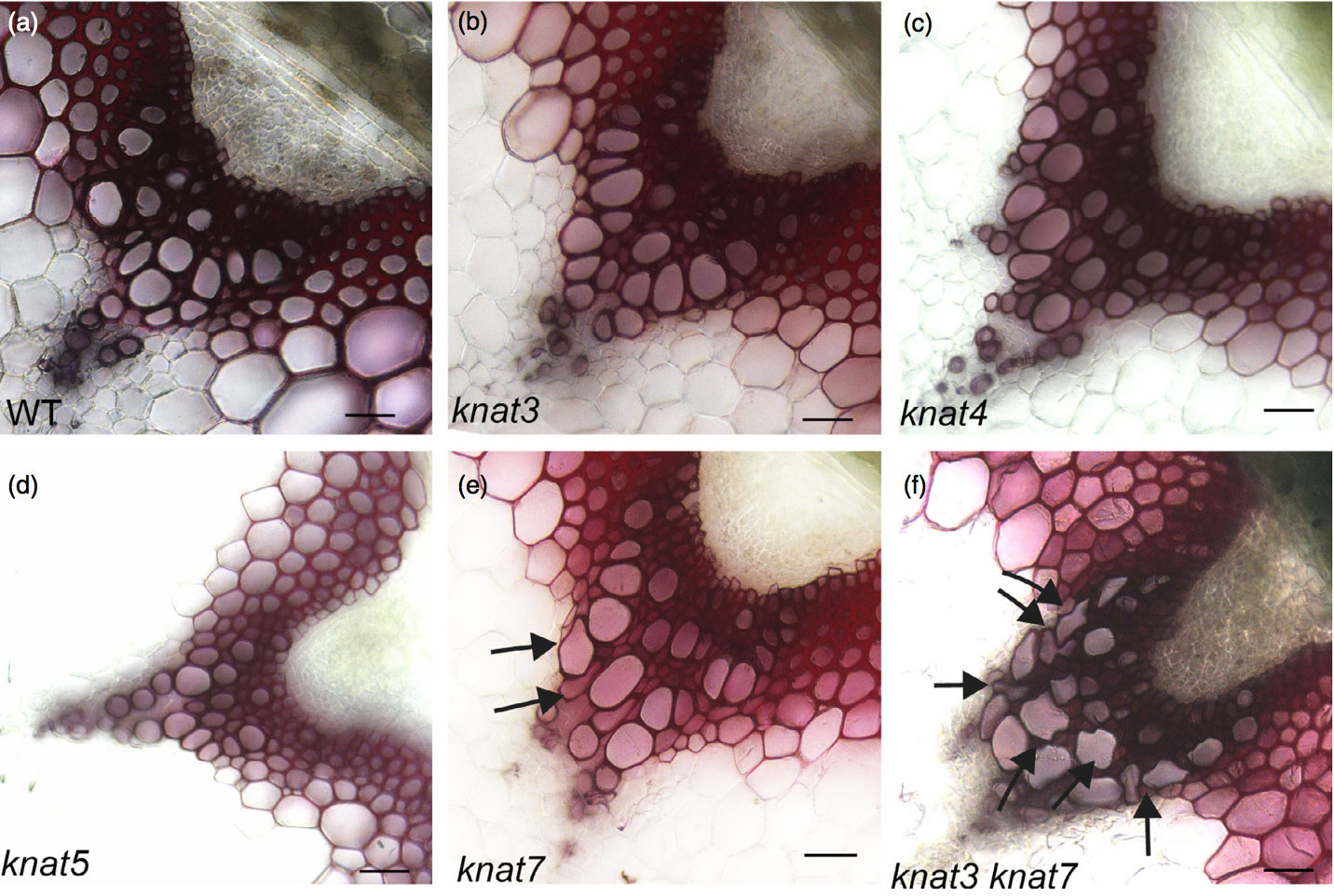博文
the plant journal:拟南芥KNAT3/7作用于花序中的次生细胞壁沉积
||
The Class II KNOX genes KNAT3 and KNAT7 work cooperatively to influence deposition of secondary cell walls that provide mechanical support to Arabidopsis stems
First author: Shumin Wang; Affiliations: University of British Columbia (不列颠哥伦比亚大学): Vancouver, Canada
Corresponding author: Shawn D. Mansfield
The transcription factor KNOTTED ARABIDOPSIS THALIANA7 (KNAT7) is a Class II KNOTTED1‐like homeobox (KNOX2) gene that, in interfascicular fibres, acts as a negative regulator of secondary cell wall biosynthesis. In addition, knat7 loss‐of‐function mutants display an irregular xylem (irx) phenotype, suggesting a potential positive regulatory role in xylem vessel secondary cell wall deposition. Although our understanding of the role of KNAT7 is evolving, the function(s) of the closely related KNOX2 genes, KNAT3, KNAT4, and KNAT5, in secondary wall formation still remain unclear. We found that all four Arabidopsis KNOX2 genes were expressed in the inflorescence stems. However, only the knat3 knat7 double mutants showed a phenotype, displaying an enhanced irx phenotypes relative to the single mutants, as well as decreased interfascicular fibre cell wall thickness. Moreover, knat3 knat7 double mutants had reduced stem tensile and flexural strength compared with wild‐type and single mutants. In contrast, KNAT3 overexpression resulted in thicker interfascicular fibre secondary cell walls in inflorescence stems, suggesting a potential positive regulation in interfascicular fibre secondary wall development. This work identifies KNAT3 as a potential transcriptional activator working together with KNAT7 to promote secondary cell wall biosynthesis in xylem vessels, while concurrently acting antagonistically with KNAT7 to influence secondary wall formation in interfascicular fibres.

转录因子KNAT7是一个II类KNOTTED1同源异型基因KNOX2,其在束间纤维中充当次生细胞壁生物合成的负调节因子发挥作用。另外,knat7功能缺失突变体显示出不规则的木质部表型,说明其可能在木质部导管次生细胞壁沉积方面发挥正向调控作用。尽管我们对于KNA7基因功能的了解逐日增加,但是其近缘基因KNAT3/4/5在次生细胞壁形成方面的作用仍不清楚。本文的,作者发现四个拟南芥KNOX2基因都在花序茎中表达。然而,仅有knat3 knat7双突变体存在明显的表型,相比于单突变体而言,不规则木质部表型缺陷更加强烈,而且束间纤维细胞壁厚度降低。此外,相比于野生型和单突变体,knat3 knat7双突变体茎的抗拉和抗弯强度均有所下降。相反,KNAT3过表达会导致花序茎中较厚的束间纤维次生细胞壁,说明其在束间纤维次生细胞壁发育过程中存在正向的调控作用。本文的工作鉴定了KNAT3基因作为一个潜在的转录激活因子,与KNAT7基因一起作用于木质部导管中的次生细胞壁生物合成,但在束间纤维中与KNAT7拮抗,影响次生细胞壁的形成。
通讯:Shawn D. Mansfield (http://profiles.forestry.ubc.ca/person/shawn-mansfield/)
研究方向:林木生物技术;基因表达和细胞壁发育性状的表型之间的关系;植物代谢组;细胞壁发育;纤维素生物合成;木质素生物合成;蔗糖代谢;人为污染(磷,盐,重金属)的修复。
doi: https://doi.org/10.1111/tpj.14541
Journal: the plant journal
First Published: October 06, 2019
https://blog.sciencenet.cn/blog-3158122-1206184.html
上一篇:Nature Communications:拟南芥WUSCHEL作为生长素响应“变阻器”维持顶端干细胞
下一篇:Current Opinion in Plant Biology:有花植物合子极性和早期胚胎发生综述
全部作者的其他最新博文
- • Plant Physiology:CsMADS3促进柑果中的叶绿素降解和类胡萝卜素合成(华中农业大学)
- • Molecular Plant:LBD11-ROS反馈调节作用于拟南芥的维管形成层增殖和次生生长(浦项科技大学)
- • Science Advances:根结线虫通过调控植物的CLE3-CLV1模块,促进侵染进程(日本熊本大学)
- • Nature Communications:油菜素内酯参与植物营养生长期转变的分子机制解析(浙江农林大学)
- • Current Biology:光合作用产生的蔗糖驱动侧根“生物钟”(德国弗莱堡大学)
- • PNAS:花同源异型基因在叶中被抑制、花中被激活的分子机制(南卡罗来纳大学)
